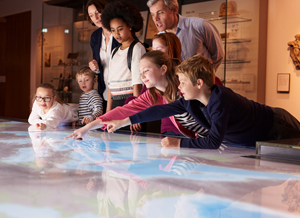
Connecting your students to their local community gives them real-world experiences and helps you maximize available resources. Young people develop a sense of civic duty when they see first-hand what their community has to offer and what they have to offer to their community. Here are some ideas to get you started.
Bring the museum to your students
Field trips to museums connect students to their community in interesting ways. If that’s out of the question at your school, ask the museum to send a representative to talk to your class.
Many museums offer traveling trunks that showcase pieces of exhibits to take around to schools. Some museums let you rent these trunks, while others offer presentations where a museum staff member comes and presents the trunk’s artifacts to a group. This is a great way to bring the museum to your students if a field trip isn’t possible. Instead of reading about and discussing fossils, students can learn directly from the fossils themselves. A movie on the Civil War might entertain students for a while, but if they’re able to learn from the actual mementos and letters of soldiers and African-Americans, they could understand those divisions in a more personal way.
An educational experience like this can ignite a student’s interest in going to museums, enable them to give back to their community and support the preservation of history and scientific evidence.
Invite local professionals to problem-solve with your students
Posing a hypothetical problem to students can get them to think critically for a moment, but presenting an actual problem in their community that relates to your curriculum can really intrigue them.
Invite a few local professionals to come into your class so students can ask them what they know about the issue and how they’ve tried to solve it. Studying what a carbon footprint is and why it matters? Why not bring in a local scientist and someone from the local waste management facility to discuss your community’s waste issues?
Together, students and professionals can discuss ideas, incentives and ways to spread awareness. Students can then create a proposal detailing a new course of action that they think should be tried and why, or they can create an informational pamphlet to spread awareness in their neighborhood.
Have students interview locals and present to the community
Incorporating interviews into your curriculum gives students a chance to learn first-hand about a local person’s experience with topics such as their experience immigrating to America or what they went through during a historic moment that occurred during their lifetime.
Students can apply what they learn from the interview to create a treasure box of mementos that represent key elements of that person’s experience, adding in symbols and writing a reflective essay or a poem. Then you can host a presentation night where students present their displays to their families and the community members who were interviewed.
This exercise creates a powerful connection between the assignment and the community, promoting diverse perspectives and illustrating the power of listening to our neighbors’ stories.
Invite a professional to lead a workshop
Inviting local professionals to share a bit of their knowledge and experience shows students how their lessons have real-world uses. Ask a retired lawyer to talk about how to build a strong argument, invite a journalist to talk about reliable sources and how to spot fake news, or bring a farmer or gardener in to talk about pesticides and organic produce.
Students can prepare questions, engage in hands-on activities with the professional, and come away feeling excited about the experience they’ve had while still learning all of the required material. It also shows them there are adults in their community who are eager to help them and hear their ideas and questions.
Involve your students in a local non-profit’s PR campaigns
Encouraging students to engage in community service is great, but another way to get them involved that can relate to your curriculum is having them create a PR campaign for a non-profit they support. Whether they’re excited by the mission of Habitat for Humanity, Relay for Life or the local food bank, you can use their enthusiasm to teach them about marketing, social media strategies, graphic design, press releases and persuasive language.
To create an effective campaign, students need to research and connect with the organization’s local staff, create an organized plan and collaborate in groups. Meaningful connections between students and non-profit organizations helps both parties feel valued.
Ideally, students will learn a great deal and better understand what exactly those organizations are doing each day to help their community and many others.
Kara Wyman has a BA in literature and a MEd from the University of California-Santa Barbara. She has worked with adolescents for a decade as a middle school and high school English teacher, the founder and director of a drama program, and a curriculum designer for high school and college courses. She works with 13- to 19-year-old students as a project manager of a non-profit organization.
Categorized as: Tips for Teachers and Classroom Resources
Tagged as: Engaging Activities, Mid-Career Teacher, New Teacher, Professional Development
